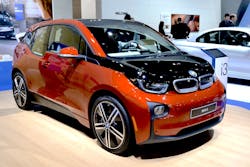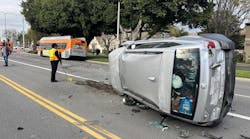Subject: Carbon Fiber
Topic: Carbon Fiber Structural Materials
Objective: Understand carbon fiber utilization in the BMW i3
Task: Given the opportunity to inspect a BMW i3 with carbon fiber materials comprising portions of its structure, the rescue team shall identify the presence of carbon fiber and preplan how to manage it at a crash incident.
In this month’s University of Extrication column, we continue our look at the use of carbon fiber reinforced plastic (CFRP) in passenger vehicle structures by focusing on the new BMW i3. This electric plug-in vehicle utilizes carbon fiber in its entire passenger compartment. Because the vehicle is fairly new to the U.S. market and is still produced in limited numbers, we have a chance to study the vehicle and its use of carbon fiber, essentially preplanning future vehicle rescue activities involving a BMW i3. First, let’s get familiar with the i3 vehicle itself and then look at exactly where carbon fiber can be found on this particular vehicle.
The i3 is classified as a compact, electric plug-in vehicle, weighing in at 2,700 pounds. It has a 450-pound high-voltage lithium ion battery mounted beneath the floorpan of the vehicle. This provides DC power to the electric motor that drives the rear wheels. The extended-range electric plug-in version of the i3 adds a small two-cylinder gasoline engine next to the electric drive motor. It acts as a generator to recharge the HV battery. The gasoline fuel tank is at the front of the vehicle ahead of the instrument panel.
There are 10 airbags, including frontal bags, front occupant seat-mounted airbags, four roof-mounted side impact airbags and dual knee bags.
Both front doors of the five-passenger i3 are of conventional design with standard latch and hinge assemblies typical of other BMW vehicles. In addition to the carbon fiber passenger compartment, of particular interest to rescue personnel is the fact that the rear doors are rear-hinged. This means there is no fixed B-pillar on either side. The front door must be opened first before the rear door will open. This is due to the rear-door latching to the front door as well as to the rocker and roofrail structures.
One reason we are looking at the BMW i3 in this series is that entire occupant area is constructed of carbon fiber, a first for a mass-produced vehicle. The complete unit is called the Life Module. It is light enough that two individuals can actually pick up the entire module by themselves.
In Part 3 of this series, we will look in detail at the extrication challenges of working with carbon fiber at crash scenes.
Read Part 1 here.






